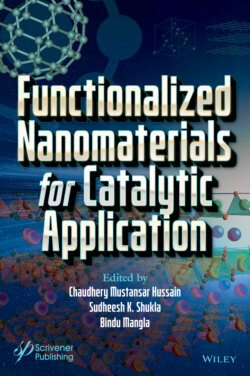Читать книгу Functionalized Nanomaterials for Catalytic Application - Группа авторов - Страница 2
Table of Contents
Оглавление1 Cover
2 Title page
3 Copyright
4 Preface
5 1 Functionalized Nanomaterial (FNM)–Based Catalytic Materials for Water Resources 1.1 Introduction 1.2 Electrocatalysts as FNMs 1.3 Electro-Fenton/Hetero Electro-Fenton as FNMs 1.4 Hetero Photo-Fenton as FNMs 1.5 Photocatalysts as FMNs 1.6 Nanocatalyst Antimicrobials as FNMs 1.7 Conclusions and Future Perspectives References
6 2 Functionalized Nanomaterial (FNM)–Based Catalytic Materials for Energy Industry 2.1 Introduction 2.2 Different Types of Nanomaterials 2.3 Synthesis of Functionalized Nanomaterials 2.4 Magnetic Nanoparticles 2.5 Carbon-Based Nanomaterials 2.6 Application of Functionalized Nanomaterials in the Energy Industry Through Removal of Heavy Metals by Adsorption 2.7 Conclusions References
7 3 Bionanotechnology-Based Nanopesticide Application in Crop Protection Systems 3.1 Introduction 3.2 Few Words About Pesticide 3.3 What About Biopesticide Demand 3.4 A Brief Look on Associates Responsible for Crop Loss 3.5 Traditional Inclination of Chemical-Based Pest Management 3.6 Nanotechnology in the Field of Agriculture 3.7 Why Nanotechnology-Based Agriculture is the Better Option With Special Reference to Nano-Based Pesticide? 3.8 Biological-Based Pest Management 3.9 Nano-Based Pest Management 3.10 Nanopesticides 3.11 Required to Qualify for Selection as Nanobiopesticides 3.12 Pestiferous Insect’s Management 3.13 Critical Points for Nanobiopesticides 3.14 Other Pests 3.15 Post-Harvest Management and Their Consequences 3.16 Field Test for Nanobiopesticides for Pest Control 3.17 Merits and Consequences of Chemical and Bionanomaterials 3.18 Conclusion References
8 4 Functionalized Nanomaterials (FNMs) for Environmental Applications 4.1 Introduction 4.2 Functionalized Nanomaterials in Environmental Applications 4.3 Conclusion Acknowledgements References
9 5 Synthesis of Functionalized Nanomaterial (FNM)–Based Catalytic Materials 5.1 Introduction 5.2 Methods Followed for Fabrication of FNMs 5.3 Functionalized Nanomaterials 5.4 Conclusion Acknowledgements References
10 6 Functionalized Nanomaterials for Catalytic Applications—Silica and Iron Oxide 6.1 Introduction 6.2 Silicon Dioxide or Silica 6.3 Iron Oxide References
11 7 Nanotechnology for Detection and Removal of Heavy Metals From Contaminated Water 7.1 Introduction 7.2 History of Nanotechnology 7.3 Heavy Metal Detective Nanotechnology 7.4 Futuristic Research 7.5 Conclusion References
12 8 Nanomaterials in Animal Health and Livestock Products 8.1 Introduction 8.2 Nanomaterials 8.3 Nanomaterials and Animal Health 8.4 Nanomaterials and Livestock Produce 8.5 Conclusion References
13 9 Restoring Quality and Sustainability Through Functionalized Nanocatalytic Processes 9.1 Introduction 9.2 Nano Approach Toward Upgrading Strategies of Water Treatment and Purification 9.3 Conclusion and Future Directions References
14 10 Synthesis and Functionalization of Magnetic and Semiconducting Nanoparticles for Catalysis 10.1 Functionalized Nanomaterials in Catalysis 10.2 Types of Nanoparticles in Catalysis 10.3 Synthesis of Nanoparticles for Catalysis 10.4 Functionalization of Nanoparticles for Application in Catalysis 10.5 Application-Based Synthesis 10.6 Conclusion and Outlook References
15 11 Green Pathways for Palladium Nanoparticle Synthesis: Application and Future Perspectives 11.1 Introduction 11.2 Biosynthesis of PdNPs and Its Applications 11.3 Conclusion and Future Perspectives References
16 12 Metal-Based Nanomaterials: A New Arena for Catalysis 12.1 Introduction 12.2 Fabrication Methods of Nanocatalysts 12.3 Application of Metal-Based Nanocatalysts 12.4 Types of Nanocatalysis 12.5 Different Types of Metal-Based Nanoparticles/Crystals Used in Catalysis 12.6 Structure and Catalytic Properties Relationship 12.7 Conclusion and Future Prospects Acknowledgment References
17 13 Functionalized Nanomaterials for Catalytic Application: Trends and Developments 13.1 Introduction 13.2 Different Types of Nanocatalysts 13.3 Catalytic Applications 13.4 Conclusions References
18 14 Carbon Dots: Emerging Green Nanoprobes and Their Diverse Applications 14.1 Introduction 14.2 Classification of Carbon Dots 14.3 Environmental Sustainable Synthesis of Carbon Dots 14.4 Characterization of Carbon Dots 14.5 Optical and Photocatalytic Properties of Carbon Dots 14.6 Carbon Dots in Wastewater Treatment 14.7 Carbon Dots for Energy Applications and Environment Safety 14.8 Biomedical Applications of Carbon Dots 14.9 Ethical, Legal, and Sociological Implications of Carbon Dots 14.10 Conclusion and Future Outlook References
19 Index
20 End User License Agreement
